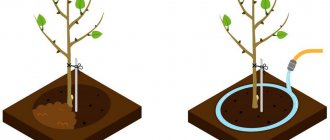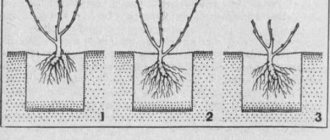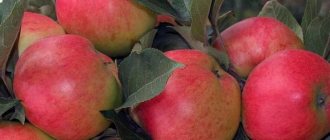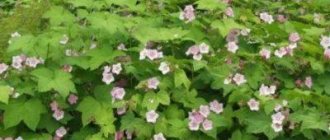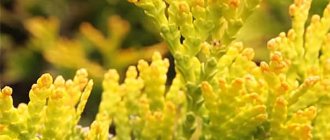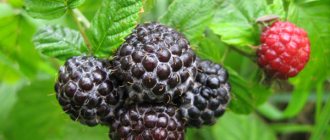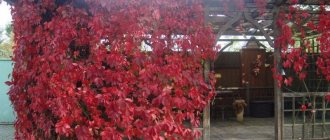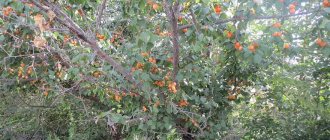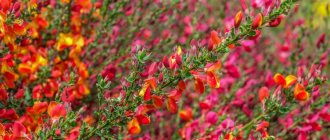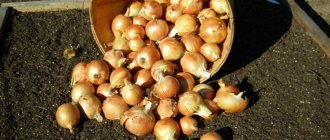When is the best time to transplant maple from the forest to the site? Transplantation from the forest
Most often, young plants are moved from the undergrowth to the dacha plot: juniper, thin mountain ash, rose hips and small conifers.
The younger the plant, the easier it will take root in a new place. For the transplant to be successful, you must follow simple rules.
2. It has been noticed that a tree or shrub takes root more easily when it is transplanted from soil rich in nutrition to soil that is less fertile. And the situation is much worse for a seedling when transplanted from soil poor in nutrients to rich in nutrition. Based on this observation, grab a couple of buckets of soil from the forest, mix it with the soil obtained when preparing the planting hole for the new plant, and do not add any fertilizers.
Margarita Turkina
The purposes of planting trees can be different - creating natural shade on a site, a hedge, wind and noise protection, creating a background for planting ornamental plant species, and so on. Trees common in natural areas, with rare exceptions, are not available in nurseries. Therefore, it is best to transplant the selected plants from their natural habitats.
How to transplant forest trees into garden plots
Many times I had to transplant different trees and shrubs from the forest to create living barriers. Successful transplants were carried out even in the summer at the height of drought (last time in the memorable hot and smoky summer of 2010, in July), and this made it possible to gradually identify a number of patterns that can help with such transplants, as well as when purchasing large forest trees in garden centers . If certain conditions are met, forest trees take root 100% (after all, in this case, we have the most favorable “mode” of replanting – day after day).
First of all, of the main “inhabitants” of our forests, I would single out three groups :
the ones that take root best are linden, maple, hazel, alder, rowan (I’m not talking about willow, even a pole stuck into the ground upside down takes root);
the worst of all are oak, pine, juniper (it is generally more profitable to grow oak from an acorn; it will still overtake the “slow” transplanted seedlings);
birch, spruce, aspen, viburnum, bird cherry, buckthorn - are in the middle , they generally take root easily if the coma is large enough and heavy watering is observed, but if the soil dries out too early, they can suddenly “turn yellow.”
Where to dig from
It is best to choose trees in a sunny place and growing separately. On the contrary, the worst seedlings are either located under the forest canopy (due to the strong shadow, the undergrowth has very slow growth; there are many “tight” trees, which are over 30 years old and dwarf in size), or grow close to an adult spruce or birch tree ( It is impossible to dig out large fibrous roots from them; you have to pull them out with a cliff - you always end up with rare bare fragments of roots and unreliable survival rate).
Once upon a time we were landscaping a new area , and it required a lot of at least temporary shelter with tree crowns from the neighbors and from the main road. The owners of the plot complained: where could they get so many large seedlings? To which I told them: we’ll go now and in a hundred meters we’ll dig up any trees. They didn’t believe it, since it took half an hour to “cut” to the distant forest. And there, right next to them, there was a railroad - the best place to look for young, strong seedlings of almost any species that grow along the edges of a clearing on a sunny slope.
Also, suitable seedlings can be found in clearings or along highways. The younger the seedling, the more accurately it will take root and quickly “pick up” strong growth to transform into a luxurious tree. Although large trees can also be successfully planted if certain conditions are met (it is almost hopeless to replant apple trees in large condition, but large linden, maple, birch, etc. can be replanted just as successfully as young trees).
Transplantation of large trees
First of all, a large tree (whose trunk is already like a club, and the crown is the size of a haystack) should be replanted only in cloudy or even rainy weather, preferably so that it remains just as cloudy in the coming days. It’s much worse if the sun shines the next day: this, of course, is not the end, with persistent watering twice a day it will take root, but it will be forced to shed some of the foliage and this year will remain ugly, although next year it will be in shape.
How fast does the maple tree grow? Norway maple: biological features
Norway maple or common maple is a deciduous tree that is widespread throughout Europe and Asia, in deciduous and mixed forests, singly or in groups. Often found in the vicinity of ash, oak, birch, and chestnut trees. It got its name because of the pointed ends of the leaves.
Did you know? Norway maple is called Acer platanoides in Latin. Acer in translation means sharp, strong.
The crown of this maple variety is dense, spherical, and widely spreading. It measures 15-20 m in diameter. The branches are strong, wide, and grow upward. The trunk is slender and powerful. Norway maple grows quite large - its height can reach 30 m. On average, the tree trunk reaches 12-28 m.
The bark of young plants is gray-brown, darkens and becomes cracked over time.
The leaves are simple, palmate, with five to seven serrated lobes. They are large in size - up to 18 cm in length and up to 22 cm in width. The upper part of the leaf blade is rich green, the lower part is lighter. In autumn, the leaves turn yellow, orange, and golden.
Maple blooms in April and the first half of May, before or after the leaves appear. The flowers are yellow-green, collected in corymbose inflorescences of 15-30 pieces. They have a pleasant aroma. Norway maple is a dioecious plant. When a maple tree blooms, male and female flowers open on different trees. Pollination occurs with the help of insects.
The fruit is a two-winged fruit. Its structure allows the wind to disperse seeds over fairly large distances from the tree. Fruiting occurs in September-October annually starting from the 17th year of life.
The root system of Norway maple is superficial, deepened into the soil by 20 cm. The lateral roots grow strongly. Very often they appear on the soil surface. The lifespan of a tree is 150 years. Although there is information about 200-300-year-old representatives of the species.
Norway maple propagates by seeds, root shoots, and grafting. Seeds require stratification. In the wild it produces a lot of self-seeding and abundant growth from the stump.
At a young age, maple grows quite quickly - with an annual increase of 45-60 cm in height and 30-40 cm in width. By the age of seven it reaches 2 m and above. The tree grows actively up to 25-30 years of age, then the rate of growth in height slows down, and the tree begins to grow in breadth. After 50 years, growth slows down or stops altogether.
It is necessary to add to the characteristics of the Norway maple that it is a good honey plant, frost-resistant and able to withstand winter temperatures down to -40 degrees, wind-resistant, easily tolerates heat and drought, can be used as a soil-improving species, and is not afraid of planting in cities or in polluted air conditions.
Did you know? Maple honey production is 150-200 kg per 1 ha. Bees collect up to 10 kg from one tree.
Norway maple has about 150 varieties, including many decorative forms that differ in size, shape and color of leaves, crown type, and growth rate. The most popular forms in gardening culture are such forms as “Purple King”, Drummond, Schwedler, spherical, standard, palm-cut and others.
Description of Norway maple
Stately trees with large palm-shaped leaves can be seen in Karelia and the Ryazan region, near Voronezh and in the Caucasus. When it comes to maple, the first thing that comes to mind is its spectacular foliage, colored dark green in summer, and by autumn acquiring all shades of gold and carmine. How not to admire such beauty!
But the tree is no less spectacular in the second half of spring, when its branches are covered with corymbose inflorescences of 15–30 fragrant yellow-green flowers. They open up until the maple leaves bloom. On sunny days, the quiet buzzing of bees and other insects attracted by the flowers comes from the crown.
The tree is an excellent honey plant; thanks to the shade formed by the foliage, it can cover an open area from the scorching sun and cold winds.
It is not surprising that the question: “How to transplant a maple from the forest to a plot or grow a seedling yourself?” interests many summer residents.
But before you decide to plant, it is important to know that an adult tree reaches a height of 30 meters and requires significant free space. The superficial root system of the maple, blocking access to nutrients and water, interferes with the growth of surrounding crops.
Planting and caring for red maple
These trees with red leaves look very beautiful in both single and limited group plantings. When planting, it is necessary to maintain a distance between seedlings of one and a half to three and a half meters. A pit for planting is prepared with a depth of fifty to seventy centimeters. If planting in a wetland, be sure to think about good drainage. When planting, the hole must be half filled with water and be sure to add complex fertilizers to the soil.
Lonely handsome man
Some varieties of red maple are specially bred by breeders for growing in tubs or containers. These plants do not exceed one and a half meters in height. Maple is planted in clay or plastic pots in lush, humus-rich soil prepared from equal parts of compost, turf soil and peat. Plants grown in pots do not like excessive soil moisture. Watering red maples, both those growing in tubs and those growing in open ground, must be combined with the application of fertilizers. The frequency of watering depends on the growing area and weather. With a lack of watering, red maple plantings survive, but lose their decorative value.
When caring for red maple, tree pruning is of utmost importance. Maple does not require radical pruning; it is enough to timely saw off damaged and dry branches. It is also necessary to promptly seal media and damage to the bark with the help of a garden varnish in order to protect the tree from pests and diseases. But this garden plant acquires a special decorative quality when it has been in the hands, or rather in the scissors, of a skilled gardener. Thanks to pruning, trees acquire truly fantastic shapes, and in combination with the color of the foliage, this creates a fabulously beautiful result.
Planting Norway maple
If the summer resident has seedlings with an open root system at his disposal, Norway maple trees are planted in the ground:
- in early spring, when the ground has thawed and the trees have not yet begun to grow;
- in the fall, before the onset of persistent cold weather.
Plants with ZCL can be planted throughout the warm period. Since the roots are not damaged, planting and caring for Norway maple will not cause any trouble even for a novice gardener.
For the seedling, choose a well-lit place, at least 2.5–3 meters away from other perennial plants. Trees need fertile soil that is permeable to moisture and air. It is useful to add sand, peat, and rotted organic matter to chernozem or clay soil before planting.
Add to poor soil in equal parts:
- garden soil;
- humus;
- bottom peat;
- 120–150 grams of complex fertilizer.
To prevent the maple root system from being damaged by stagnation of melt and groundwater, a 15-centimeter drainage layer of expanded clay, broken brick or crushed stone is poured onto the bottom of a wide planting hole.
If the roots of the tree are exposed, they should be placed in water for several hours before planting. The seedling in the container is watered abundantly so as to wet the entire earthen ball.
The prepared plant is placed in a hole next to a pre-fixed support so that the root collar is slightly above the soil level. The planting hole is filled with prepared soil, the soil is compacted and watered. The tree trunk circle is generously mulched with dry soil, peat or other suitable material to prevent drying out of the soil.
Ginnala maple transplant. Description of appearance
In autumn, this crop decorates the garden with its beautiful foliage. Ginalla maple (in other words, riverine maple) comes from the genus of the same name and the Sapindaceae family. This shrub does not differ in height and changes foliage every year. The height of the tree can vary from 3 to 8 meters. The crown is spreading, wide, and has the shape of a tent. The diameter of the crown can reach up to seven meters.
The bark is small in thickness, brown in color with a gray tint. In older crops, the bark is usually covered with cracks. The branches are thin and erect, colored brown and red.
The root system is of a superficial type with abundant density. The leaves are arranged oppositely, reach a length of 10 centimeters, and a width of about five. All leaves are divided into three separate lobes, the middle lobe is elongated. Over time, the section begins to become less noticeable. The leaves grow on straight petioles with a total length of up to five centimeters, and are often colored pink. The surface is smooth, dark green in color.
Inflorescences on maple trees form in spring, when the leaves have fully developed. The flowers are yellow-green. Average sizes in diameter can reach up to 0.8 centimeters. The inflorescences create solid panicles and emit a pleasant scent. The flowering process lasts two to three weeks.
At the end of summer, paired lionfish appear on the tree, which subsequently form fruits. Their length reaches up to a centimeter and width up to five centimeters. At first the fruits are red in color, but over time they begin to become dark.
The tree's growth rate is moderate. In one year, from 30 to 50 centimeters are added, everything will depend on the growing conditions of the crop. The lifespan of this tree is long. The crop can grow for about 100 years, but trees have been noted that continued to grow for 250 years.
The maple leaf has been used by Canadians as a state symbol since the 17th century. Since 1965, it began to be used on the official flag of the state. The plant was awarded this honor due to the fact that sugar maples are an important economic resource for the country; they are used during timber harvesting, in the extraction of sugar, and also for the preparation of nutritious maple syrup, which helps improve human health.
How does maple spread?
In nature, Norway maple easily reproduces by seeds and root shoots.
Young plants appear in abundance around the stumps of old maples. Wind-dispersed seeds germinate, becoming dense undergrowth. If desired, it is not at all difficult to propagate the plant yourself. To harden the seeds, they are planted in the ground in the fall. Seedlings with several leaves dive in spring. Further care before planting the Norway maple in a permanent place consists of regular watering, weed control and protecting the seedlings from the cold.
How to plant maple at home. Ripening, collecting and preparing seeds for planting
Different maple species reproduce in different ways. This can be cuttings or grafting, seeds. Maple seeds ripen in August, and they begin to fall to the ground with the onset of autumn. Those who want to grow a maple tree with their own hands need to collect them by finding them among the fallen leaves.
The maple seed looks like a double flat lionfish with a pair of wings. The fruit itself consists of two parts, where each seed is bare and contains a large green embryo.
Today there are about 150 species of maples, most of which are native to North America. Maple feels good both in tropical areas and in northern regions. Maple seeds are planted both in spring and autumn. To plant them in the spring, they are prepared in the fall, creating an artificial winter for them by placing them in the refrigerator in a container with wet sand. Under these conditions, the seeds can be stored for up to two years. With the onset of spring, from April to May, the seed can be planted in the ground. Before planting, it is recommended to soak them in peroxide for two days, so they will germinate faster, in about three weeks.
When planting in autumn, choose a place on the site that is quiet and sunny, dig a hole 70 cm deep and 50 cm wide. A sand-peat mixture mixed with soil from digging is introduced into this hole. The seeds are planted to a depth of four cm and with their wings up.
The seedling grows slowly; at one year of age the tree can reach a height of 80 cm. The seedling requires good watering. A handsome tree grown from a seed will create excellent shade with its chic crown and a place to rest, and the seeds and leaves will help in the treatment of kidney diseases and colic, bronchitis and herpes, etc. Maple has positive energy, and growing it from a seed is a long-term investment for descendants.
Sugar maple
According to biologists, for normal growth, maple seeds for planting must be taken either local or from a similar climate, planted in light loamy soil, watered and protected from the north wind.
Maple propagation
Maples reproduce well by seeds. They can also be propagated by cuttings, but the percentage of rooting of cuttings is quite low. Therefore, it should be resorted to only if it is not possible to obtain seeds from the mother plant. Seeds are sown in a seedling bed in the fall so that they undergo natural stratification during the winter. In spring, the seeds germinate well. You can sow seeds in early March, but it is also necessary to stratify within 5 - 7 days.
Many maple species produce a mass of root suckers, which can also be successfully used for propagation. Flexible shoots without roots coming from the main trunk, as well as semi-lignified annual branches, can be rooted by air or root layering.
To obtain aerial layering, the following technique is used: on the scion or branch from which the layering is going to be obtained, the bark is cut obliquely several times with a clean, sharp knife, and the cut sites are treated with a root formation stimulator (root, heteroauxin). Then small clean pebbles or grains of foam are inserted into the cuts to prevent the edges of the bark from merging. After this, the incision site is wrapped in damp sphagnum moss, topped with a plastic bag and sealed tightly. Next, you need to protect the site of the cuts from solar overheating by wrapping it over polyethylene with aluminum foil or canvas. Gradually, roots will develop at the site of the cuts, which will be immersed in sphagnum. Such cover on the cuttings should be preserved until next spring, when, during the time of active growth, it will be possible to cut the cuttings from the mother plant, carefully free the roots from foil and plastic film and plant them directly in the ground with moss.
How to propagate maple. Planting maple and caring for it. How to grow maple in the country.
- Thanks to its extraordinary decorativeness and flexible nature, maple is often used in landscape design in the Moscow region. Planting and caring for maple does not cause any particular difficulties, and the returns from it are very high. The tree is undemanding to soil and tolerates frost. And if the young shoots freeze in winter, in the spring it will grow new ones.
Landscape design studio STROY-LAWN invites you to create a design project for your site, as well as professionally carry out planting and landscaping work.
Elegant foliage attracts attention throughout the warm season. In spring, inflorescences of small bright yellow fragrant flowers stand out clearly against the background of blossoming burgundy leaves. The grown leaves turn green and take on the shape characteristic of each species and variety: five-fingered, carved, pointed. There are variegated forms of maples with variegated foliage. All summer long, bright red, pinkish, yellowish-green clusters of winged fruits stand out against the background of maple greenery. In September, the ripened seeds lose their brightness, but it is then that the leaves begin to change their color. In different species they are scarlet, yellow, orange, pink, burgundy.
And even the trunks of these trees can be decorative. The Tatarian maple has black bark, while the fan maple has greenish, light brown, beige bark. There are several varieties of snakebark maples. Their trunks are covered with an unusual “snake” pattern: alternating white and green or brown vertical stripes.
Planting and caring for a maple tree does not include trimming. This is one of the few trees that independently forms a beautiful, dense, symmetrical crown. If the plant is not used in a green hedge, it does not need to be pruned annually. The trunk grows straight and slender, and the beneficial shade of the dense crown saves the surrounding area from the heat.
Using maple in landscape design. Photo
Maple is quite often used in landscape design. This tree is amazingly beautiful and resilient. You can meet these beauties in almost any city park. The undoubted advantage of using maple to decorate a site is its shade, stateliness and ideal crown shape, as well as the abundance of colors in the fall, which are pleasing to the eye. Despite all these advantages, some gardeners may caution you against growing maple on your property. This is due to the maple’s ability to self-reproduce and quickly grow new trees. Thus, the maple is able to fill the entire nearby space. If your dream of having a maple tree in your yard is so strong, then choose a remote, spacious area where you no longer plan to make any plantings in the form of flower beds, vegetable gardens, etc. In the photo you can see and feel all the beauty of this deciduous tree.
As you can see, to make an ideal shady place in your garden to relax in the hot heat, you don’t need much. Like any plant, the maple needs your care and affection, and it will definitely reciprocate your feelings. Don't be afraid to take on the challenge of growing this beautiful tree. Good luck!
Vegetable garden and more
Ash-leaved maple is widely used in the landscape design of city parks and streets. This is an unpretentious, fast-growing tree with a luxurious crown, providing cool shade in the summer heat and withstanding unfavorable environmental conditions.
The leaves, in shape more similar to the greenery of an ash tree, gave the tree such a specific name. On one petiole there are from three to seven large serrated leaves, uniformly green or variegated - in the flamingo variety, which change color with the onset of autumn to yellow or red.
The ash-leaf maple reaches a height of 20 meters, the girth of the crown is up to 14 m. Such a massive tree by garden standards will find a place only on a large summer cottage plot. In ornamental gardening, a smaller copy is most often used - the flamingo variety.
Tips for growing maple on your site
How nice it is to hide in the shade of a thick, spreading tree in the summer heat! On your own property, you often want to acquire a “shelter” that would provide good protection from the sun’s rays, would be a beautiful decoration for the lawn, and wouldn’t be too fussy in terms of maintenance.
So why don't you try growing a maple tree? These beautiful trees from the maple family have been loved by many of us since childhood: songs and poems are written about them, autumn wreaths are woven, and the pointed multi-colored palm-shaped leaves are used for various kinds of creativity. So why not have such beauty in your own garden?
Of course, many gardeners can immediately express their doubts: mature trees can reach 25 meters in height, while the crown circumference will be 15-20 meters! Of course, for a small garden plot such giants may be a bad idea.
But maple is a tree that has many types and varieties, some of them are very small and decorative, but have not lost the charm of their larger counterparts.
Plant propagation methods
Some varieties produce abundant root shoots. To propagate such trees, it is enough to dig up a young seedling in the spring, separate it from the mother tree, and plant it in a new place.
Varietal maples are propagated in two ways:
- Seeds.Before planting, maple seeds require stratification. They can be kept for 3 months in the refrigerator at a temperature of 0 to 4 °C. Or sow seeds in open ground in the fall at a depth of 3–5 cm. Young shoots appear from them in the spring, which are best covered for next winter.
- By cuttings and grafting. This method is more often used in garden centers to obtain good quality seedlings. Cuttings of varietal maples are grafted onto a ready-made rootstock with a developed root system.
When growing maples, it is necessary to control their spread, as this easily occurs by self-seeding, and weed out unwanted shoots in a timely manner.
Pests and diseases of Norway maple
Trees planted on the site are exposed to pest attacks and the risk of various diseases.
The enemies of maple are whiteflies, mealybugs and some types of leaf rollers. To defeat insects, insecticide treatments are used throughout the growing season. Be sure to collect and destroy fallen leaves in autumn. Pathogenic fungi pose a great danger. They call:
- various types of spots;
- necrosis,
- deformations;
- rot;
- Verticillium wilt or wilt;
- powdery mildew.
Manifestations of Norway maple disease, as in the photo, are foreign spots on the leaves, deformation and wilting of shoots, and “witch’s brooms.”
Sometimes the color of the wood changes, the leaves dry out for no apparent reason. The affected parts of the plants are cut out, the foliage is collected and destroyed. Maple is treated with fungicides in 2-3 doses. The exception is wilt. Infected trees are dug up by the roots and burned, since pathogens remaining in the soil affect not only maples, but also potatoes, sunflowers, beets, and other crops.
